 Leading Blog | Posts by Month |
 Leading Blog | Posts by Month |
04.30.19

LeadershipNow 140: April 2019 Compilation
See more on 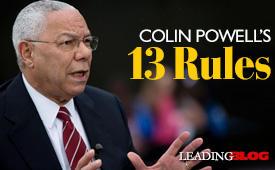 
Posted by Michael McKinney at 06:59 AM
04.29.19

16 Rules for Effective Decision-Making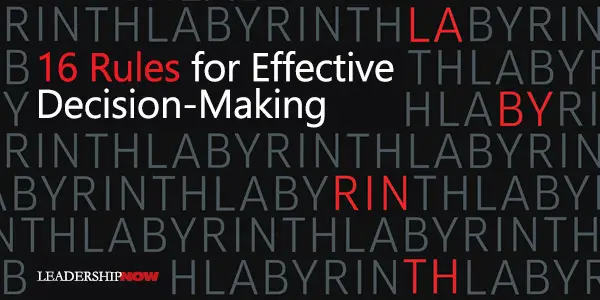
WHERE WE GO in life is determined by the choices we make. How we make those decisions becomes critical. The speed of change, the abundance of choices, the unknown unknowns, and the impact of a connected world, all conspire to make decision-making a labyrinth. We face traps everywhere. In Labyrinth: The Art of Decision-Making, Pawel Motyl examines “The most prevalent weak spots in decision-making processes, not only in business but in life in general; during crisis and calmer times; in both individual and group decisions.” I agree with Motyl that “We really do live in a world where everything is out of whack and everything we thought we knew is being called into question.” It calls for a deeper look at not just what we think, but more importantly how we think and a clear understanding of how we got there. Motyl digs into the series of decisions that led to some of the modern world’s most dramatic events: from the Cuban missile crisis to the 1996 Mount Everest climbing disaster; from the Apollo 13 rescue mission to the ill-fated Daimler–Chrysler merger. Using many and varied examples Motyl reveals 16 rules for effective decision-making. The rules with the accompanying narrative are well-researched and intriguing. Here is the overview: Rule #1
Rule #2
Rule #3
Rule #4
Rule #5
Rule #6
Rule #7
Rule #8
Rule #9
Rule #10
Rule #11
Rule #12
Rule #13
Rule #14
Rule #15
Rule #16

Posted by Michael McKinney at 09:06 AM
04.26.19

How to Use Discomfort to Drive High-Performance
IT SHOULD go without saying that coaching as opposed to just managing people, is the key to developing high-performance organizations and teams. Leaders must be coaches. Any growth but especially growth leading to high-performance requires a degree of discomfort. It is the job of the coach to maintain a healthy discomfort for those on their team. In The Coaching Effect, Bill Eckstrom and Sarah Wirth have created the Growth Rings model to show why exponential and sustained growth only occurs in a state of discomfort.
The Growth Rings illustrate differing environments that exist in our world and how they either promote or hinder growth. Each ring encompasses one of four primary environments: Stagnation, Order, Complexity, and Chaos. Stagnation is a low-performing or low/no growth environment. “Stagnation is a situation in which people may need to follow too many steps, get someone else’s permission, or deal with minutia that stifles creativity, independent thought, or action.” Chaos is the opposite of stagnation but is also characterized by low performance and low growth. This can be a temporary state and brought on by external forces. Chaos is characterized by uncertainty and a lack of control. Order is the state we naturally gravitate to as it is the most comfortable. It is characterized by predictability and while in certain circumstances that can be desirable, it can also be catastrophic. Order doesn’t engender growth. Complexity creates growth. When you change what you input into an environment, you trigger Complexity. The discomfort introduced by Complexity brings growth. You can’t permanently exist in this state because you need a degree of order. The job of a coach is to how and when to introduce Complexity for individuals and teams. To define what a coach does, the authors introduced the Coaching Performance Equation:
Developing a trusting Relationship allows you to know what creates Order and Complexity for each member on your team, because Order to one may be Complexity to another. And great coaches know what unique buttons to push or levers to pull for each of their team members. Of all the activities a coach can engage in, the authors found that these four are the most important in terms of obtaining results: 1. One-to-One Meetings: “Proactive, consistent ono-to-one meetings are necessary to generate trust, communication, and accountability with team members.” And probably the most important coaching tool. Certainly, a lack of coaching negatively affects the performance of a team, but so does too much. More is not always better. Their research shows that the best performing coaches had meetings very two or more weeks. 2. Team Meetings: Boring comes to mind. Rather than talking the whole time, this is s a good opportunity to listen and let the team members share ideas with each other. “Team members want information, ideas, and training so they can do their jobs better.” 3. Performance Feedback: Good feedback is a gift. Providing good feedback is a skill that coaches must develop. The foundation of good feedback is trust. It needs to be clear, positive, timely, and specific. Describe rather than evaluate. “If we could offer only one piece of advice to coaches who want to improve their feedback, it would be to ask more questions.” 4. Career-Development Plans: This is often overlooked but one of the most important activities to team members. This is not necessarily about promotions. “Instead, you, your team, and your organization must think of career development as a way to help people grow and develop their skills and experiences for whatever their current and future goals may be.” You may have noticed that this requires a big time commitment and is probably the main reason most leaders avoid good high-performance coaching. They like the result but don’t feel they can take the time. In many ways it comes down to the fact that we like Order. But introducing good coaching, while it adds Complexity, brings desired results more than anything else a leader could do. The authors begin the book by asking, what does it feel like to be coached by you? They conclude by asking, what should it feel like to be coached by you?” 
Posted by Michael McKinney at 07:37 AM
04.24.19

Is Your Organization Digitally Mature?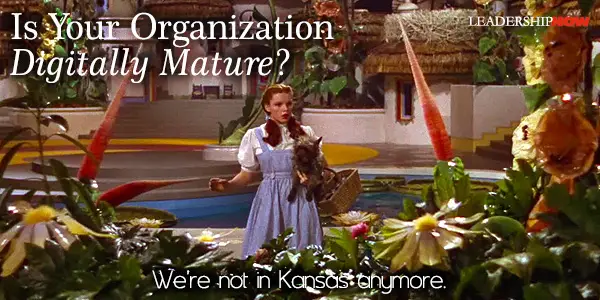
WE’RE not in Kansas anymore. Unlike Dorothy in the movie version of the Wizard of Oz, there’s no going back. Many companies experience digital disruption in the same way as the tornado in the Wizard of Oz—swept up by forces beyond their control. But the story is not about the tornado, but how they made their way through the strange new world they found themselves in. In the same way, digital disruption is not about the technology as much as it is about how companies can make their way through the new competitive environment they find themselves in. Digital disruption is more about the people than it is the technology. People are the focus of The Technology Fallacy by Gerald Kane, Anh Phillips, Jonathan Copulsky, and Garth Andrus. “It’s about how to manage disruption, adapt to disruption, and thrive in a world and a time marked by disruption.” The main problem facing organizations is not the pace of change itself but the “uneven rates of assimilating these technologies into different levels of human organization.” Technology changes faster than individuals can adopt it (the adoption gap); individuals adapt more quickly to that change than organizations can (the adaptation gap), and organizations adjust more quickly than legal and societal institutions can (the assimilation gap). Each of these gaps poses a different challenge for companies. Digital Maturity The authors introduce the concept of digital maturity. “Digital Maturity is about continually realigning your organization and updating your strategic plan to account for changes in the technological landscape that affect your business.” Digital maturity should be the goal that most companies should aspire to in order to compete in a digital world. They note that the idea of tightly aligning an organization's people, tasks, structure, and culture is not new; it plays out differently because the conditions under which those management principles operate has changed. Digital maturity is a gradual, ongoing process. In a digitally mature company, the digital strategy is a core part of the organization’s overall business strategy. Business should experiment with new technologies, but more importantly, they need to be able to “clearly articulate why they need to invest in these technologies or what business purpose they could serve.” Digital leaders need to focus on business value. Digital strategy isn’t just thinking of new initiatives that enable organizations to do business in the same way but slightly more efficiently. Instead, it involves fundamentally rethinking how you do business in light of all the digital trends occurring both inside and outside your organization. It involves identifying potential new services, sources of revenue, and ways of interacting with employees. What About Leadership? Does the essence of leadership really change in the digital age? Or are greater and greater levels of uncertainty causing us to forget the essentials and focus on the latest bright and shiny object? The fundamental principles of leaders never change. We tend to forget that in the face of rapid change. New environments demand a different emphasis. The authors rightly note, “Digital leadership is just leadership, albeit in a somewhat new environment.” But what is different? “Leaders cannot readily assume that any information can be kept private and must be prepared to deal with all situations publicly.” They shared this from the Australia and New Zealand Banking Group (ANZ): The second skill needed to be a great leader in today’s context is to be inherently curious. Today’s leaders need to lead through influence rather than through command and control. That’s quite hard for people who have really only had one quiver [sic] in their leadership bow, which is command and control. What they meant was arrow but point well taken. I liked the metaphor. The point they make regard command and control has always been so, but in the industrial age you could get away with it, so it has become the baggage we have to deal with. What Skills Do Digital Leaders Need? From their research, the most important skill is transformative vision and a forward-looking perspective. This includes not just knowledge of markets and trends, but how they are evolving and how the business should respond. It would be the ability to know what is foundational to the business and what changes are relevant and might impact that base. Next is digital literacy. That is, understanding the general principles of how a technology works and thus the possibilities that come from so that one can determine if a particular technology is or is not relevant for certain business applications. It is difficult to provide purpose and direction if you have no idea how or why a technology will impact your business. A leader must be change-oriented or open-minded. Willing to adapt and comfortable with a changing environment. Beyond this, a leader must demonstrate the ability to deliver and decisively lead the organization into the future. One other key difference to leadership in a digital age: where leadership is found within the organization. In the twentieth century hierarchical corporation, people looked only to the top of the org chart for leadership. With the pace of change, that is no longer practical—nor is it always where you can find effective leadership. When we talk about leadership, we are referring to leadership at all levels of the organization. Digital Talent Attracting and keeping digital talent is a challenge for many organizations. With the pace of change and innovation, not only must individuals have a growth mindset, but organizations must also create a culture of growth and continuous learning. The focus for all needs to be on lifelong learning. Even for the digital natives, time marches on. While older generations have much to learn from the millennials, the fact that they are early adopters doesn’t mean they necessarily know how to adapt that technology in an organizational setting. “Millennials are not inherently digital, at least not in an organizational sense. They may have adopted technology individually, but they will not instinctively know how to help your company adapt. Even if they come out of college more digitally minded than their older counterparts, that edge will atrophy without continuous learning and a growth mindset.” Continuous learning is your best defense in a changing environment. The authors go on to discuss the conditions for successfully adapting to digital disruption that most organizations will need to create. They address such topics as organizing, cross-functional teams, enabling stronger collaboration, cultivating a more experimental mindset, and an approach for measuring digital maturity in your organization. 
Posted by Michael McKinney at 07:34 AM
04.22.19

Becoming a 100X Leader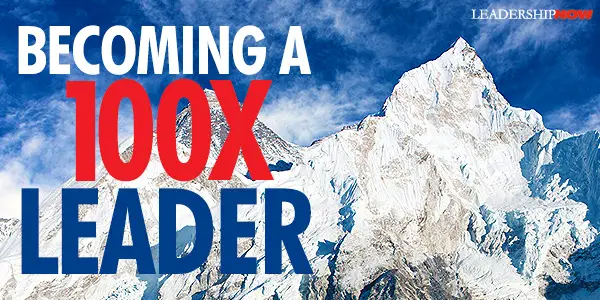
A 100X LEADER is a 100% healthy leader who multiplies that mindset to those they lead. A leader that climbs their own Mount Everest every day and acts as a Sherpa to others at the same time. A 100X leader has become a leader worth following and builds leaders worth following. Jeremie Kubicek and Steve Cockram wrote The 100X Leader to help you become a 100X Leader in all spheres of influence in your life—leading yourself, a company, a team, or a family—and to become a Sherpa for others. Your climb to becoming a 100X leader begins with self-awareness and courage. The courage “to invest in yourself and what is most important in your life, the courage to do difficult things that are contrary to your natural tendencies, the courage to hold up a mirror and take a hard look at what others see and wish you would do something about, the courage to make the subtle changes you view as insignificant but are likely the most important to others, the courage to stay at it when the positive results see slow to come.” You don’t become a 100X leader by accident. It’s hard and requires a deliberate process. Kubieck and Cockram guide you through that process. Leading yourself or others is a balance between the right amount of support and challenge. “Support means to provide the appropriate help others need to do their jobs well.” To equip them. Challenge “means to motivate people by holding them accountable to what they could do if they had the resources.” It is important to remember that we must begin with support before we challenge. Support builds trust. “The art of leadership is the appropriate calibration of support and challenge at a specific moment, in a specific context for a specific reason.” The authors present the Support-Challenge Matrix shown below. You want to operate in the top right quadrant—liberate—as much as you can. Each quadrant represents a different leadership style and the culture it creates.
Dominator
Protector
Abdicator
Liberator
Being a Liberator means knowing how other people experience you and then helping others to do the same. It’s being intentional about what you are doing. Having the humility to “commit to a process of uncovering our weaknesses. Our natural tendencies don’t really change, but with intentionality, humility, and effort we can begin to have a choice between the default patterns of how we normally respond to a situation and what we actively choose to do or say instead.” We liberate ourselves from leading on autopilot. Once we liberate ourselves, we can then help others see the mountain ahead of them and equip them to get to the next level. Kubieck and Cockram provide a comprehensive look at how to become a 100X Leader by showing us the mountain and then illuminating the way and providing the tools and equipment necessary to complete the climb. Climbing Mount Everest is dangerous and demanding, but without a Sherpa, it is virtually impossible. The 100X Leader is our Sherpa and teaches us how to become a Sherpa for others. And as with the Sherpa, success is measured by not how many times they reach the top of Everest but by how many they have helped reach the summit. 
Posted by Michael McKinney at 09:38 AM
04.17.19

6 Tips to Improve Your Hiring Process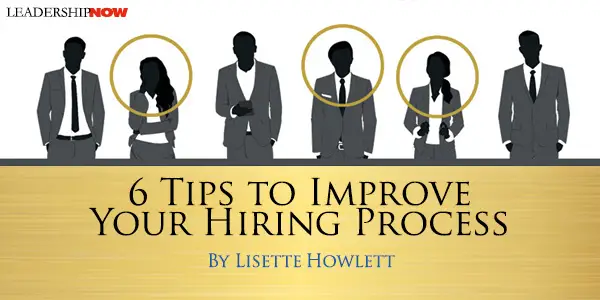
ONE OF THE MOST significant ways a leader can impact their business is through the quality of their hiring, yet this is rarely listed as a critical leadership competency and often overlooked. In my experience, this is usually because the impact is not as immediately visible as for example when they make an investor presentation that goes badly or fails to convince the Board during a key presentation. Yet the cost of poor hiring is considerable, not just in terms of hiring unsuitable candidates (time, money, reputation, impact on colleagues) but also in terms of the damage poor hiring processes can have on your organization. Candidates who experience an unsatisfactory hiring experience are considerably less likely to accept a job offer (especially the top quality hires facing a choice of offers that you will be most wanting to attract); and in addition candidates will share their hiring experience which will put off other applicants thus reducing your talent pool and also potentially impacting your reputation and brand image with current and potential customers. The case for improving hiring competence within leaders and the organization is strong and here are six tips that will help you improve your hiring process and your quality of hiring:

Posted by Michael McKinney at 12:01 AM
04.15.19

5 Insights to Managing Chaordic Tension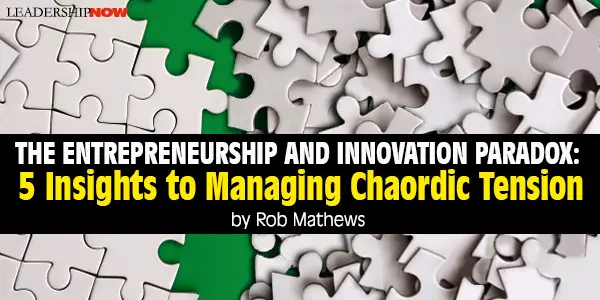
CONDUCTING your own orchestra. Running your own ship. Self-employment. Putting your stamp on the world. Entrepreneurship is a great, noble profession. However, failure rates are well documented. According to the Small Business Administration, about half of all businesses fail within five years (PDF). Some statistics show even higher failure rates. Are entrepreneurial endeavors really that risky? The answer is complicated. Intuitively, yes, entrepreneurship is a risky career path. But on the other side of that equation is the influence of sound business practices, planning, due diligence, and adaptability on business success. I’ve coached literally thousands of entrepreneurs in my twenty years in higher education and the business world, and have owned multiple businesses during that time. Between my research and that experience, I’ve developed some insights into what makes a venture a success or a failure. Visa’s founder, Dee Hock, coined the phrase chaordic tension to describe the tug of war between order and chaos in organizations. Managing this tension is the key to success in growing and stable organizations—regardless of industry, size, years in business, or profit motive. Here are my five insights on how to manage chaordic tension: 1. Idea people are more comfortable with risk. I’m a big believer in the power of assessments. One of the assessment tools we use a great deal is the Basadur Innovation Profile. This instrument measures one’s preferences for engaging the innovation process. The results are presented in a four-quadrant model. People who prefer to use the information to come up with ideas (generators and conceptualizers) are on the right side of the vertical axis. These individuals are comfortable with ideas, ambiguity, and keeping their options open. Not surprisingly, our research indicates generators and conceptualizers are generally not all that scared of entrepreneurial risk and thus reported higher intentions to start an entrepreneurial venture. 2. Evaluative people can execute and sustain ventures. According to the Basadur Innovation Profile, people who prefer to use information to judge or evaluate (optimizers and implementers) in the innovation process are on the left side of the vertical axis. These folks tend to frustrate the idea people, but their logic and sense of urgency to perform help entrepreneurs accomplish their dreams. As you can imagine, according to our research, evaluative people are much more hesitant to take risks, and thus report much lower intentions to start a new venture. This is where it gets interesting. We’ve also found that these evaluative types become much more comfortable with new ventures after creativity training and a better understanding of the ideation process. Not surprisingly, they also report higher intentions to start a business, or at least increased comfort with joining an entrepreneurial venture. They tend to like imaginative ideas. The important lesson here is that building cognitively diverse teams—who develop respect for and appreciation of their evaluative/ ideator opposites—is a key to success. The balance maintains company vibrancy while also advancing the business. More on these concepts in insights 4 and 5. 3. Assumptions and the value propositions must be validated—and developed accordingly. As with most things in life, a little humility goes a long way, particularly when it comes to entrepreneurial ventures. Former Disney Parks and Resorts executive, Lee Cockerell, often says that feedback is a gift. I happen to think feedback is an especially helpful display of generosity when money is involved. Generators and conceptualizers are generally not overly offended by customer and employee feedback, so they can be more nimble in terms of pivoting the offering and value proposition. On the flip side, optimizers and implementers know when to forge ahead with a workable business model and generate all-important revenue and profits. The yin and the yang of these two distinctly different ways of using information is an important component of failing fast (a lean startup) while also moving the venture in a forward direction. 4. Quirkiness makes startups special, but transitioning to professionalism grows and sustains businesses. Entrepreneurial ventures live on the edge. Open office concepts, bikes hanging from the ceiling on makeshift pulleys, and quirky props and toys are pretty much the norm in startups with high-growth potential (especially ones started by generators!). Flywheel in Omaha, Nebraska even has an open beer and wine fridge in its main office. Here’s the thing: Ventures that grow and maintain success will develop some level of professionalism by creating systems and processes that create some order. And it’s optimizers and Implementors who lead the charge when it comes to establishing order and professionalism. 5. Companies with longevity preserve entrepreneurial spirit. Not to be confusing, but having just praised professionalism and order, I’d be remiss if I didn’t close by stressing the importance of preserving the entrepreneurial spirit of growing and stabilized ventures. One of the key ingredients of successful entrepreneurial ventures is the quirky, free-spirited culture they have. They use their personalities as fuel to escape the challenges of the unknown. Losing this is essentially losing one of the company’s most sacred competitive advantages. It’s as if the heart of the organization just stops beating one day. I recently visited the Flywheel headquarters in Omaha. Since its 2012 inception, the company has grown into a gazelle with more than two hundred employees. It has raised several million dollars in venture capital, and its Local by Flywheel platform has reached more than one hundred and fifty thousand downloads. Talking with Dusty Davidson, one of the founders, I discerned that the company is a poster child for mastering that challenging balance between order and chaos, and stifling institutionalization versus free-flowing entrepreneurial spirit. How does Flywheel do it? It honors both the necessity of systems and processes (order) to build an efficient business model, and the sacred importance of quirky personalities and the free flow of ideas. Finally, Flywheel built a balanced team that holds each other accountable for staying true to these two distinctly different but equally important paradigms. Davidson’s message would be that you too can accomplish this—with intentional team-building, humility, adaptability, and a careful dose of professionalism. 
Posted by Michael McKinney at 11:15 AM
04.05.19

Why Leaders Need to Think More Like Professional Gamblers
ONE OF the unfortunate side effects of living in an age of accelerating technology is having to deal with increased uncertainty. When faced with uncertainty, how should leaders react? Should they make a big bet, hedge their position, or just wait and see? We tend to see situations in one of two ways: either events are certain and can, therefore, be managed by planning, investment, and reliable budgets; or they are uncertain, and we cannot manage them. You can, however, embrace uncertainty by adjusting your views as new information becomes available. In order to do that, you need to learn something about Thomas Bayes, an English clergyman, and mathematician who proposed a theorem in 1763 that would forever change the way we think about making decisions in ambiguous conditions. Bayes was interested in how our beliefs about the world should evolve as we accumulate new but unproven evidence. Specifically, he wondered how he could predict the probability of a future event if he only knew how many times it had occurred, or not, in the past. To answer that, he constructed a thought experiment. Imagine a billiard table. You put on a blindfold, and your assistant randomly rolls a ball across the table. They take note of where it stops rolling. Your job is to figure out where the ball is. All you can really do at this point is to make a random guess. Now imagine that you ask your assistant to drop some more balls on the table and tell you whether they stop to the left or right of the first ball. If all the balls stop to the right, what can you say about the position of the first ball? If more balls are thrown, how does this improve your knowledge of the position of the first ball? In fact, throw after throw, you should be able to narrow down the area in which the first ball probably lies. Bayes figured out that even when it comes to uncertain outcomes, we can update our knowledge by incorporating new, relevant information as it becomes available. Many years later, French mathematician Pierre-Simon Laplace developed Bayes’s idea into a powerful theory, which we now know as the Bayes Theorem. Here is a simple explanation of it. Beginning with a provisional hypothesis about the world, assign to it an initial probability of that event happening, called the prior probability or simply the prior. After collecting new, relevant evidence, recalculate the probability of the hypothesis in light of the new evidence. This revised probability is called the posterior probability. You can find evidence of Bayesian thinking throughout modern history, from nineteenth-century French and Russian artillery officers adjusting their cannons to Alan Turing trying to crack the German Enigma codes. Bayes has even influenced the design of machine learning techniques, notably the naive Bayes classifier. Bayes is relevant to modern leaders because it can help them develop an approach to uncertainty that is less deterministic and more probabilistic. Even when events are determined by an infinitely complex set of factors, probabilistic thinking can help you identify the likeliest outcomes, and so make the best decisions. Viewing the information probabilistically enables you to describe one of many possible outcomes, some more or less likely than others. One of the key advantages of thinking probabilistically is that it equips you with a more critical perspective to evaluate new data as it becomes available. Data can be imperfect, incomplete, or uncertain. There is often more than one explanation for why things happened the way they did; by examining those alternative explanations using probability, you can gain a better understanding of causality and what is really going on. Deterministic models produce a single solution that describes the outcome of an experiment given appropriate inputs; in other words, for every possible input, there is a single output. A probabilistic model distributes over all possible solutions and provides some indication of how likely it is that each will, might, or can occur. The human mind is naturally deterministic. We generally believe that something is true or false. Either you like someone, or you don’t. There is rarely a situation when you can say that there is a 46 percent probability that someone is your friend. In fact, unless you are a teenager and have a lot of frenemies, you are probably quite deterministic about your social circle. Our instinct for determinism may well have been an evolutionary innovation. To survive, we had to make snap judgments about the world and our response to it. When a tiger is approaching you, there is really not a lot of time to consider whether he’s approaching as a friend or a foe. However, the deterministic approach that kept our ancestors alive while hunting in the savannah won’t help you make good decisions in complex, unpredictable environments when your natural mental shortcuts and heuristics start to fail you. One of the best ways to embrace uncertainty and be more probabilistic in your approach is to learn to think like a professional gambler. Take, for example, Rasmus Ankersen. Ankersen, a Dane living in London, originally came to the UK to look for an English publisher for his book on human performance, the writing of which had taken him from Kenya to Korea in search of why great athletes, whether they are runners or golfers, tend to come from the same small regions. One of the reasons he decided to stay in London was a chance meeting with a professional gambler named Matthew Benham. Benham is a renowned, albeit somewhat inaccessible, figure in the British gambling world. After graduating from the University of Oxford with a physics degree, he went into securities trading, first at Yamaichi International and then at the Bank of America. This was followed by a stint working as a trader for Premier Bet with Tony Bloom, one of the most successful gamblers in the world. That inspired Benham to leave his day job and focus on gambling. He went on to start two successful gaming companies, Matchbook, a sports betting exchange community, and Smartodds, which provides statistical research and sports modeling services. When Ankersen and Benham met, they started talking about how soccer (except, of course, they called it football) was a sport that was yet to be disrupted by data and probabilistic thinking. Benham was impressed enough to invite Ankersen to help run Brentford Football Club, which he had recently acquired. Soon after, Benham also bought Midtjylland, the soccer club in Ankersen’s hometown. Ankersen’s insight was this: soccer is one of the world’s unfairest sports. Although there is a saying that “the league table never lies,” in Ankersen’s opinion that is exactly what it does. Because soccer is a low-scoring sport, the win/loss outcome of a game is not an accurate representation of the actual performance of a team, and therefore the intrinsic value of its players. From a professional gambler’s perspective, the key to placing a good bet is to continually update your position with relevant insights that impact the probability of an event occurring. Rather than trying to be right, gamblers try to be less wrong with time. Benham and Ankersen started to use the scientific application of statistics—the “Moneyball” technique pioneered in baseball— when assessing the performance of a team. Their key performance metric became “expected goals” for and against a team, based on the quality and quantity of chances created during a match. The point of this exercise was to develop an alternative league table, which might serve as a more reliable predictor of results and a better basis on which to value and acquire players. As an algorithmic leader, you will also find having a probabilistic mindset useful, and not just when you want to place a bet in the office fantasy soccer competition. Let’s consider a few examples. A probabilistic HR manager will examine the data about where a company’s best people come from and how they perform throughout their career to identify new sources of talent that may have been overlooked. A probabilistic sales professional will be conscious that it’s not enough to simply close lots of deals; it’s important to also think about where leads come from. How many opportunities were created organically, as opposed to being fed through an existing pipeline? How many new customers churn after just a few months? By understanding the data around which leads go on to become great customers, a sales leader can then work closely with their marketing colleagues to figure out new sources of potential customer prospects. Probabilistic risk managers will think about the future of how they work. While their job may have been setting or applying strict credit policies in the past, they may now start to wonder whether their traditional credit rating models are still effective. Are there low-risk segments in their customer base that they may have missed and that a new competitor may be able to target? Developing a probabilistic mindset allows you to be better prepared for the uncertainties and complexities of the algorithmic age. Even when events are determined by an infinitely complex set of factors, probabilistic thinking can help us identify the most likely outcomes and the best decisions to make. 
Posted by Michael McKinney at 07:16 AM
04.03.19

Will Artificial Intelligence Take Your Job?
A PEW RESEARCH CENTER study found that Americans are roughly twice as likely to express worry (72%) than enthusiasm about a future in which robots and computers are capable of doing many jobs that are currently done by humans. Of course, people have always worried that technology would take over their job. Gutenberg’s press probably created more social upheaval than any technological advancement has yet to do today. The sixteen-century Vicar of Croydon warned, “We must root out printing or printing will root us out.” A dire situation indeed. The term artificial intelligence first appeared in an article by Stanford professor John McCarthy in 1979. Ever since, artificial intelligence or cognitive technologies as it is often referred to, have been slowly developing in capability and application. Thomas Davenport states in The AI Advantage that, “AI is a largely analytical technology, and that for most organizations working with AI is a straightforward extension of what they do with data and analytics.” He notes: Artificial Intelligence isn’t going to transform the work of organizations—or the lives of individuals—as fast as many people seem to expect. It will be one of the many technologies that comply with Amara’s Law (named after the scientist and futurist Roy Amara): While the estimates vary between 5 and 47 percent of jobs to be lost to automation, Davenport believes it will be much closer to 5 percent. What he sees happening is something quite different. Rather than large-scale automation, he believes we will see large-scale augmentation or “smart humans working in collaboration with smart machines.” Why? A few of the reasons he gives are: First, AI tends to support or automate tasks, not entire jobs. Second, most managers neither want nor expect large-scale automation. We have seen chatbots and cognitive-engagement apps in customer service and sales, but they are not taking away jobs. Rather they are allowing these functions to handle more without adding staff. “Some organizations are planning to transition customer-support personnel to more complex activities that bots can’t yet do including handling customer issues that escalate, conducting extended unstructured dialogues, or reaching out to the customer before they can call in with problems.” Third, massive automation will not take place based on our experience from previous generations of technology. For example, there are about the same number of bank tellers despite the introduction of ATMs and internet home banking technologies. Fourth, what we see are new roles and skills emerging as people find new jobs and tasks to perform when previous tasks are taken over by automation. Finally, a lot of entirely new jobs will be created. “New jobs created by AI will fall into three categories: trainers, explainers, and sustainers.” What Can We Do? Broadly speaking there some skills that will be valuable in the workforce to collaborate and maximize your value. Being Conversant with How Machines Think “Knowing the logic and flow of a computer system is important for anyone who works alongside or oversees smart machines. Acquaintance with how systems think can be helpful in troubleshooting, understanding limitations, and explaining the operation of cognitive technologies.” Having an Understanding of Analytics and Data Structures “Understanding statistics, data structures, and how to make decisions from them will be of help to anyone seeking to work with AI.” Becoming Familiar with Different Types of AI Especially for those who seek managerial roles, this knowledge is essential. “It is impossible for someone to sponsor and implement a project involving image recognition, for example, if they don’t know that deep learning is the most likely method to doing a good job of it.” Having Domain Knowledge of the Business and Industry “Anyone who wants to work alongside smart machines in a business will need to understand not only the machines themselves, but also the aspects of the business to which they are applied.” Possessing A Strong Ability to Communicate This skill cannot be stressed enough. “As machines take on more decisions and actions, one of the key tasks left for human workers is effectively communicating the outcomes of machine activities to other humans.” Having High Levels of Emotional Intelligence Computer systems don’t possess much in the way of emotional intelligence. “That means humans have a competitive advantage in the workplace if they are perceptive, sensitive, and insightful about human emotions.” To maintain your advantage, you need to always be learning too. Curiosity wards off defensiveness and keeps you ahead of the curve. So always be learning. Davenport has written an interesting book and covers other aspects of the cognitive technologies such as cognitive strategy, and managing the organizational, social, and ethical implications of AI. AI is really nothing more than the manipulation of data. Understanding the questions to ask, how to put it together, and interpreting what it means, will be critical functions in the future. Instead of pushing data, the need will be for those who can pull intelligence from it. 
Posted by Michael McKinney at 07:49 AM
04.01.19

First Look: Leadership Books for April 2019Here's a look at some of the best leadership books to be released in April 2019. Don't miss out on other great new and future releases.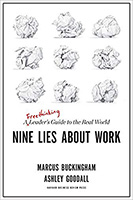 Nine Lies about Work: A Freethinking Leader’s Guide to the Real World Nine Lies about Work: A Freethinking Leader’s Guide to the Real WorldMarcus Buckingham and Ashley Goodall There are some big lies--distortions, faulty assumptions, wrong thinking--that we encounter every time we show up for work. Nine lies, to be exact. They cause dysfunction and frustration, ultimately resulting in workplaces that are a pale shadow of what they could be. But there are those who can get past the lies and discover what's real. These freethinking leaders recognize the power and beauty of our individual uniqueness. They know that emergent patterns are more valuable than received wisdom and that evidence is more powerful than dogma. 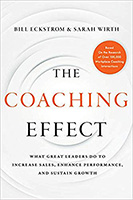 The Coaching Effect: What Great Leaders Do to Increase Sales, Enhance Performance, and Sustain Growth The Coaching Effect: What Great Leaders Do to Increase Sales, Enhance Performance, and Sustain GrowthBill Eckstrom and Sarah Wirth The authors share three critical performance drivers, along with the four high-growth activities that coaches must execute to build a team that is motivated to achieve at the highest levels. Through both hard data and rich stories, Eckstrom and Wirth demonstrate how leaders can measure and improve their coaching to lead their teams to better results. 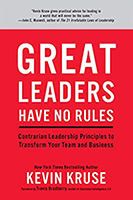 Great Leaders Have No Rules: Contrarian Leadership Principles to Transform Your Team and Business Great Leaders Have No Rules: Contrarian Leadership Principles to Transform Your Team and BusinessKevin Kruse Kevin Kruse debunks popular wisdom with ten contrarian principles for better, faster, easier leadership. Grounded in solid research and three decades of entrepreneurial experience, this book has one purpose: to teach you how to be both the boss everyone wants to work for and the high achiever every CEO wants to hire—all without drama, stress, or endless hours in the office  Labyrinth: The Art of Decision Making Labyrinth: The Art of Decision MakingPawel Motyl Every day, we make countless choices, yet we rarely stop to consider how we arrive at those decisions as we speed through our lives. In Labyrinth, leadership expert Pawel Motyl believes it’s time to take a closer look at how we make decisions―and learn how to decide better. Motyl digs into the series of decisions that led to some of the modern world’s most dramatic events: from the Cuban missile crisis to the 1996 Mount Everest climbing disaster; from the Apollo 13 rescue mission to the ill-fated Daimler–Chrysler merger. Along the way, he reveals 16 rules for effective decision-making that will challenge your pre-existing beliefs, and change your outlook forever. 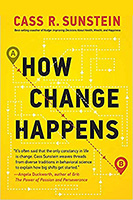 How Change Happens How Change HappensCass Sunstein Sunstein focuses on the crucial role of social norms―and on their frequent collapse. When norms lead people to silence themselves, even an unpopular status quo can persist. Sometimes change is more gradual, as “nudges” help produce new and different decisions. And finally, he considers social divisions, social cascades, and “partyism,” when identification with a political party creates a strong bias against all members of an opposing party―which can both fuel and block social change.  Build your leadership library with these specials on over 39 titles. All titles are at least 40% off the list price and are available only in limited quantities. “No two persons ever read the same book.” — Edmund Wilson
 
Posted by Michael McKinney at 08:08 AM
|
BUILD YOUR KNOWLEDGE


How to Do Your Start-Up Right STRAIGHT TALK FOR START-UPS 
Grow Your Leadership Skills NEW AND UPCOMING LEADERSHIP BOOKS 
Leadership Minute BITE-SIZE CONCEPTS YOU CAN CHEW ON 
Classic Leadership Books BOOKS TO READ BEFORE YOU LEAD |
|